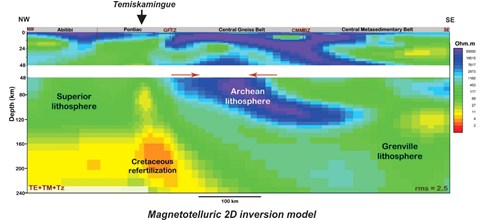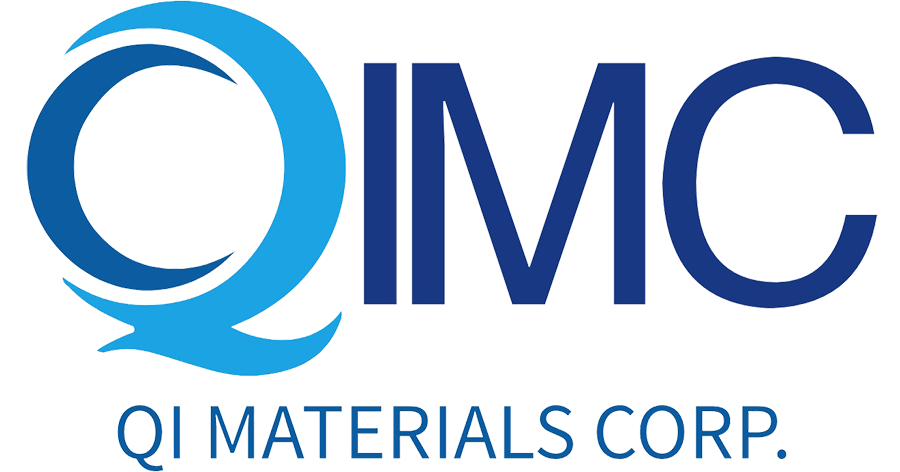Quebec City, Quebec–(Newsfile Corp. – July 16, 2024) – Quebec Innovative Materials Corp. (CSE: QIMC) (FSE: 7FJ) (“QI Materials”, “QIMC” or the “Company”), is pleased to announce a significant milestone in its Ville Marie hydrogen project. A rigorous and comprehensive review of data conducted by the Institut National de la Recherche Scientifique (INRS) has outlined the existence of a deep favorable geological structure, in the Témiscamingue area, as another potential source for hydrogen.
The presence of this mantle source is a third potential source for hydrogen which adds to the Grennstone belt (ultramafic, iron formation) and potassic (Cobalt group arenites) sources already present on the QIMC properties. This marks a critical step forward in QIMC’s efforts to establish itself as a leader in clean energy solutions.
Mr. John Karagiannidis, CEO of Quebec Innovative Materials, commented, “We are thrilled with the results of the INRS review, which solidifies our confidence in the feasibility and sustainability of hydrogen within our Ville Marie project. Marc Richer-Laflèche and his team at INRS have been on our Ville Marie site since July 1st and commenced the hydrogen soil gas sampling program. These developments not only support our commitment to environmental stewardship but also positions Quebec as a frontrunner in the global hydrogen economy. The geological and geophysical data and interpretations for the Témiscamingue region, and more specifically for the Témiscamingue Graben highlight QIMC and INRS’ currently ongoing regional exploration program for gold natural hydrogen.”
Deep Geophysical Evidence
As part of its hydrogen and helium exploration strategy in Quebec, QIMC and INRS have selected the Lake Temiskaming Graben area for its unique geological context, which marks the transition between an Archean greenstone belt rich in ultramafic (komatiites and peridotites) and iron formations (Baby’s Gp) and the Cobalt Group sedimentary rock basin (Proterozoic). This transition zone is also affected by graben faults and the emplacement of a Cretaceous kimberlite field. These observations indicate that the area has been active for over 2,700 million years, as evidenced by the record of supracrustal and igneous rocks in the region. Geological Survey of Canada aquatic seismic data from Lake Témiscamingue show that a strong earthquake affected the Lake Témiscamingue basin during the Quaternary, and the very large number of epicentres recorded in the area of Lake Kipawa (southern extension of the graben) indicates that the graben is still a tectonically active zone. This geological context could be favorable for the transfer of gas from deep sources to the surface.
Marc Richer-LaFlèche, scientific head of INRS’ applied geoscience laboratory commented: “Compiling previous data from Témiscamingue and other areas, it is clear that the geology of the Témiscamingue region is just as complex and anomalous at greater depths, particularly in the continental crust and lithospheric mantle. For example, deep geophysical studies have been carried out in Abitibi, Témiscamingue (Pontiac subprovince) and the Grenville tectonic province to investigate the lithosphere to depths of over 300 km. These magnetotelluric studies were conducted as part of the Lithoprobe Transect Abitibi-Grenville (Boerner et al., 2000) and Polaris (Eaton et al., 2005) projects. 2D (Adetunji et al., 2014; 2015) and 3D (Roots and Craven, 2017) modeling of these data show geoelectric images highlighting strong anisotropies in the lithospheric mantle between 235 and 140 km and a more focused extension visible down to 60 km depth (e.g., Figure 1).”

Figure 1.Electrical resistivity model of the lithospheric crust and mantle from Abitibi in the north to Grenville in the south (source: Figure 2 of Adetunji et al., 2015). Note the strong anomaly in the Pontiac, which is attributed to Cretaceous re-fertilization of the lithospheric mantle.
To view an enhanced version of this graphic, please visit:
https://images.newsfilecorp.com/files/7968/216592_1dcbf29f34422b3b_001full.jpg
Marc Richer-LaFlèche commented: “The presence of strong anisotropies in the lithospheric mantle at Témiscamingue, highlighted by the magnetotelluric surveys, is corroborated by teleseismic data measured in the same region (Rondenay et al., 2000) (Fig. 2). These data indicate the presence of strong P-wave propagation anisotropies, which underscore disturbances in the structure of the lithospheric mantle.The geoelectric and seismic heterogeneities observed in the lithospheric mantle of Témiscamingue are interpreted as disturbances resulting from the emplacement of kimberlites and other alkaline magmas of Mesozoic (Cretaceous) age. The interaction of these magmas with peridotites seems to have metasomatized the mantle, modifying its chemical, mineralogical, acoustic and electrical properties. The presence of water, hydrogen or graphite could explain the observed disturbances (e.g. Selway, 2013; Roots and Craven, 2017).”
Circulation of H2O- and CO2-rich kimberlite magmas in fluid-saturated cratonic peridotites and metasomatic reactions with peridotites could be favorable for hydrogen production and transport, which would occur mainly by molecular diffusion and hydrogen incorporation into hydrous magmas or aqueous fluids (e.g., Demouchy and Bolfan-Casanova, 2016).

Figure 2. Vertical section at 500 km depth showing strong anisotropy in P-wave propagation values. Teleseismic images from Rondenay et al. (2000).
To view an enhanced version of this graphic, please visit:
https://images.newsfilecorp.com/files/7968/216592_1dcbf29f34422b3b_002full.jpg
References:
Adetunji, A.Q., Ferguson, I.J., Jones, A.G., 2014. Tectonophysics Crustal and lithospheric scale structures of the Precambrian Superior – Grenville margin. Tectonophysics 614, 146-169.
Adetunji, A. Q., I. J. Ferguson, and A. G. Jones, 2015. Re-examination of magnetotelluric responses and electrical anisotropy of the lithospheric mantle in the Grenville Province, Canada, J. Geophys. Res. Solid Earth, 120, 1890- 1908
Boerner, D. E., R. D. Kurtz, and J. A. Craven, 2000. A summary of electromagnetic studies on the Abitibi-Grenville transect, Can. J. Earth Sci., 37, 427-437.
Demouchy, S. et Bolfan-Casanova, N., 2016. Distribution and transport of hydrogen in the lithospheric mantle. Lithos, 240-243, 402-425.
Eaton, D. W., et al.,2005. Geophysical arrays to investigate lithosphere and earthquake hazards in Canada, Eos Trans. AGU, 86, 169-173, doi:10.1029/2005EO170001.
Rondenay, S., Bostock, M.G., Hearn, T.M., White, D.J., and Ellis, R.M., 2000. Lithospheric assembly and modification of the SE Canadian Shield- Abitibi-Grenville teleseisrnic experiment. J. of Geophysical Research, vol. 105, No. B6, 13735-13754.
Roots, E. and Craven, J.A., 2017. 3-D modelling of magnetotelluric data from the Abitibi and Pontiac subprovinces of the Superior Province, Ontario and Quebec. Geological Survey of Canada Open File 8233. 24 pages.
Selway, K., 2013. On the causes of electrical conductivity anomalies in tectonically stable lithosphere. Surv. Geophys.. http://dx.doi.org/10.1007/s10712-013-9235-1
About the INRS and Pr. Marc Richer-LaFlèche, P.Geo.
The Institut National de la Recherche Scientifique (“INRS”) is a high-level research and training institute. Pr. Richer-LaFlèche’s team has exceptional geological, geochemical and geophysical experience specifically in the regions of QIMC’s newly acquired claims. They have carried out over six years of geophysical and geochemical work and collected thousands of C1-C4 Soil-Gas analyses.
M. Richer-LaFlèche also holds an FRQNT grant, in partnership with Quebec MRN and the mining industry, to develop and optimize a Soil-Gas method for the direct detection of mineralized bodies and faults under Quaternary cover. In addition to sulphide gases, hydrogen was systematically analyzed in the numerous surveys carried out in 2023 in Abitibi, Témiscamingue and also in the Quebec Appachian. M. Richer-LaFlèche is the Qualified Person responsible for the technical information contained in this news release and has read the information contained herein.
In addition, the INRS team has several portable gas spectrometers and the sampling equipment and logistics necessary for taking gas samples and geophysical measurements on the ground or in the aquatic environment. He is a professional geologist registered with the Ordre des géologues du Québec and is the Qualified Person responsible for the technical information contained in this news release and has read the information contained herein.
For more information about Quebec Innovative Materials Corp. and its products, please visit www.qimaterials.com
About Québec Innovative Materials Corp.
Québec Innovative Materials Corp. is a mineral exploration, and development company dedicated to exploring and harnessing the potential of Canada’s abundant resources. With properties in Ontario and Québec, QIMC is focused on specializing in the exploration of white (natural) hydrogen and high-grade silica deposits, QIMC is committed to sustainable practices and innovation. With a focus on environmental stewardship and cutting-edge extraction technology, we aim to unlock the full potential of these materials to drive forward clean energy solutions to power the AI and carbon-neutral economy and contribute to a more sustainable future.
QUÉBEC INNOVATIVE MATERIALS CORP.
John Karagiannidis
Chief Executive Officer
Tel: +1 438-401-8271
For further information, please contact:
Email: info@qimaterials.com
Neither the Canadian Securities Exchange nor its Regulation Services Provider (as that term is defined in the CSE policies) accepts responsibility for the adequacy or accuracy of this news release and has neither approved nor disapproved the contents of this news release.
Forward-Looking Statements
This news release contains statements that constitute “forward-looking statements”. Such forward-looking statements involve known and unknown risks, uncertainties and other factors that may cause Québec Innovative Materials’ actual results, performance or achievements, or developments in the industry to differ materially from the anticipated results, performance or achievements expressed or implied by such forward-looking statements. Forward-looking statements are statements that are not historical facts and are generally, but not always, identified by the words “expects,” “plans,” “anticipates,” “believes,” “intends,” “estimates,” “projects,” “potential” and similar expressions, or that events or conditions “will,” “would,” “may,” “could” or “should” occur.
Although Québec Innovative Materials believes the forward-looking information contained in this news release is reasonable based on information available on the date hereof, by their nature, forward-looking statements involve assumptions, known and unknown risks, uncertainties and other factors which may cause our actual results, performance or achievements, or other future events, to be materially different from any future results, performance or achievements expressed or implied by such forward-looking statements.
Examples of such assumptions, risks and uncertainties include, without limitation, assumptions, risks and uncertainties associated with general economic conditions; adverse industry events; future legislative and regulatory developments in the mining sector; the Company’s ability to access sufficient capital from internal and external sources, and/or inability to access sufficient capital on favorable terms; mining industry and markets in Canada and generally; the ability of Québec Innovative Materials Corp. to implement its business strategies; competition; and other assumptions, risks and uncertainties.
The forward-looking information contained in this news release represents the expectations of the Company as of the date of this news release and, accordingly, is subject to change after such date. Readers should not place undue importance on forward-looking information and should not rely upon this information as of any other date. While the Company may elect to, it does not undertake to update this information at any particular time except as required in accordance with applicable laws..

